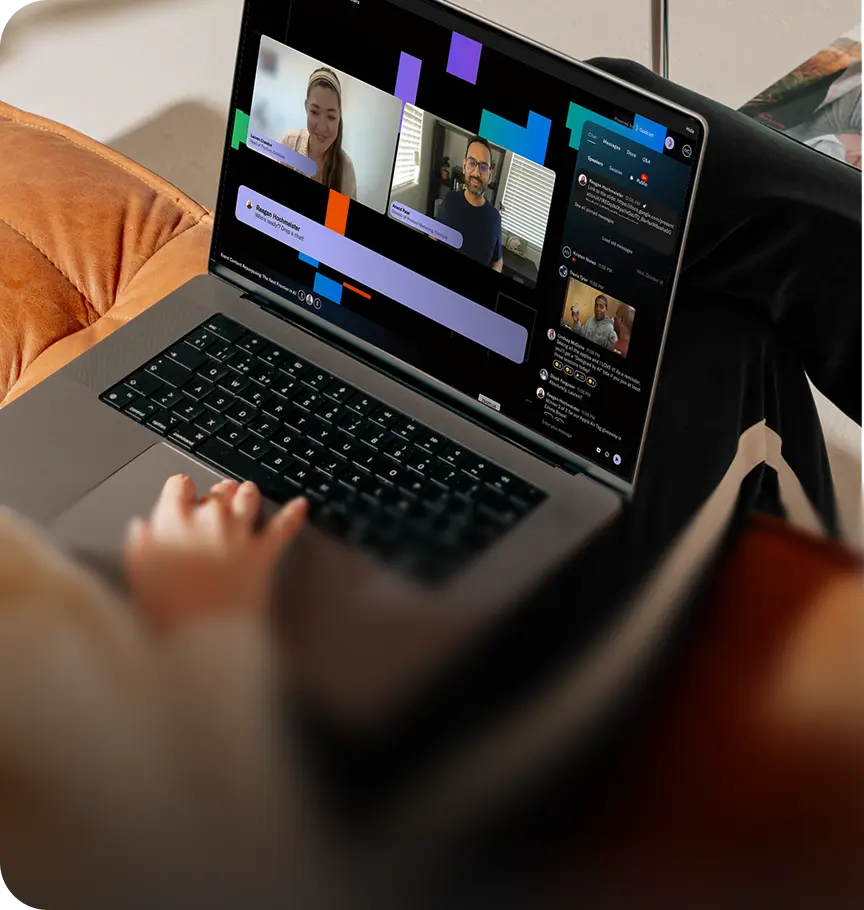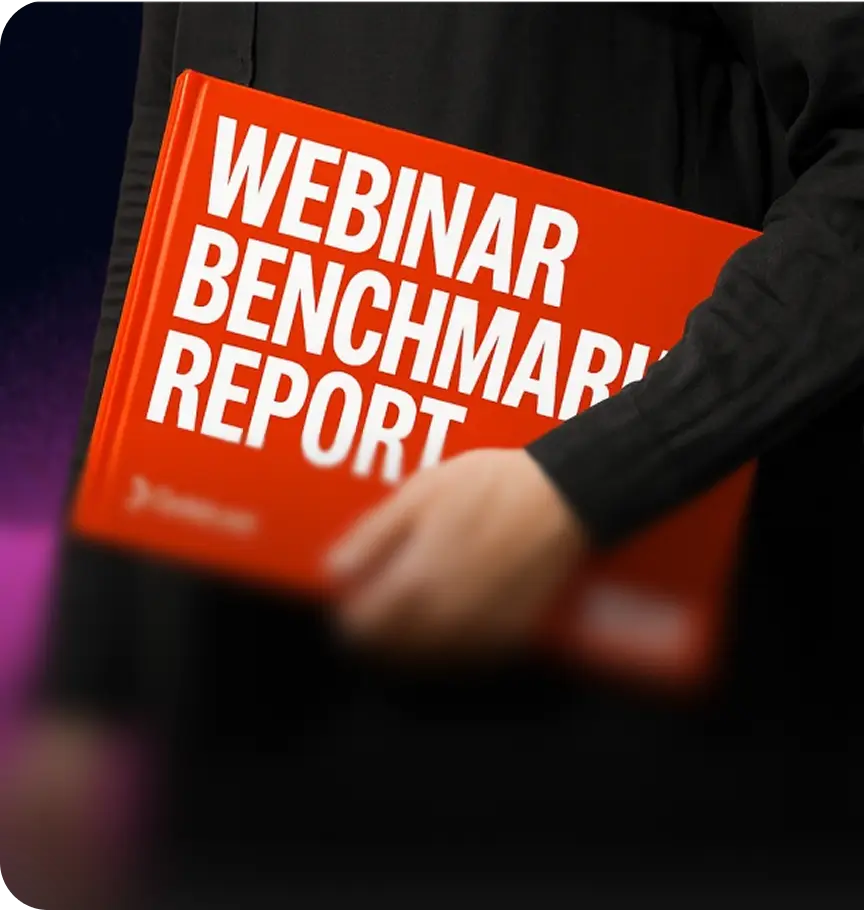Customer Story Video Production 101 for B2B Marketers

Table of Contents
Maximize Your Marketing ROI
Join 10,000 other marketers already getting the best tips on running engaging events that boost pipeline and create raving fans.
When it comes to showcasing your product's value, nothing beats the power of satisfied customers sharing their success stories.
While written testimonials and case studies have been a B2B marketing staple for decades, customer testimonial videos deliver significantly higher impact, with some studies revealing that customers remember 95% of a video review and only 10% of written ones.
If impactful testimonial video production sounds appealing to you, but you're a bit intimidated by the skill and investment required, you're not alone. Many B2B folks in particular are great at gathering info for testimonials and putting together written assets, but they haven't started with video production yet.
The good news? With today's AI tools and purpose-built B2B marketing video platforms, there couldn't be a better time to start! In this guide, we'll walk you through everything you need to know about creating customer stories as a powerful marketing tool— from choosing the right customers to feature to distributing the final product across platforms.
What are customer story videos and why are they impactful?
Customer story videos are any video content that include your customers. Think: customer testimonials, case studies, and product demos — basically, any video that features real people sharing their firsthand experiences with your brand.
We've found these videos are amazing material to repurpose into other assets as well, like social clips and audiograms!
Video testimonials are so powerful because they capture Mindshare. It's harder than ever to capture and hold audience attention, but video marketing gets it done. Interesting video content creates a memorable impression and helps you stay top of mind with your target audience long after they've watched your video, with the hope that you come to mind first when it's time to purchase.
Other benefits of video testimonials include:
- They build trust by providing valuable content to viewers. People tend to trust their peers more than companies, so hearing straight from a customer about their positive experiences will go a long way with your potential customers.
- Video performance can be tracked and analyzed. Most social media and marketing platforms provide detailed insights into how people responded to your video: how long they watched, what they did after, etc. This can help inform your video strategy.
- Videos encourage engagement. Viewers are more likely to comment, share, click, and follow up on video content. Interactive videos, for example, have a click-through rate (CTR) that's four times higher than other types of content.
Ultimately, video customer stories make your audience feel connected to your brand. They can see themselves in the shoes of the customer, experiencing the success they did via your brand, and they file that association away until they're ready to buy.
Customer story video production in 10 steps
Creating effective customer testimonial videos might seem challenging, but we've broken down the production process into a step-by-step approach that anyone can try.
1. Shortlist your customers
Not every customer is the right fit for your video testimonials. Think about customers who have achieved measurable, impressive results with your product and are good storytellers (or can be coached to be).
You also want someone who represents your ICP so that your audience relates to them. Get your sales and marketing teams involved and gather their suggestions as well.
2. Reach out to potential features
A great time to reach out and ask customers to do a story is right after a big success or positive outcome. You should personalize your request, explaining why that story is valuable to your audience, and be clear about the amount of time and investment required.
3. Choose the best story format
During pre-production, you'll need to choose the right format. You might solicit input from your customer here, or you might make the decision on your own.
Interview-style videos are pretty common, but you might also want the customer to demonstrate a workflow in the video, or perhaps you opt for a "day in the life" type of video, where the viewer accompanies the customer throughout several business activities.
4. Write the script
You don't want the video to sound overly scripted, so balance providing structure with leaving room for them to improvise and tell their story in their own words. You could also make a list of the key points you want the customer to cover and let them decide how to script it.
Generally, you want to include these points:
- Customer background info: who they are, what their company does
- Challenge they faced
- How they found your product and why they chose it
- Results
5. Select the right software
Look for platforms like Goldcast Recording Studio that offer high-quality videos, easy video editing, branding options, and the ability to not only distribute recordings, but repurpose them afterward into other types of content. It's also important to be able to monitor the performance of your video over time, so look for analytics capabilities in the software you choose.
6. Don't forget about hardware
You'll need some baseline equipment to pull this off, but don't think you have to spend a ton of money upfront. A typical smartphone works just fine for recording. You'll also benefit from a microphone and some sort of affordable lighting kit, if you're going to be on camera. There are lots of budget-friendly recs out there!
7. Record the video
Test all of your equipment beforehand so that you aren't surprised on Recording Day; you might even do a runthrough of the full conversation to help your customer loosen up and feel prepared. Use multiple angles whenever possible to give viewers some variety, and always record more content (including b-roll footage) than you need. It's easier to cut what you don't want than to go back and capture new content!
8. Brand and edit the video
It's post-production time!
Consistent branding helps viewers connect the customer story to your company. Apply branded elements to the video, including your brand color palette and company logo. When editing, aim to keep the entire clip a few minutes long and cut filler words, long pauses, or any awkward transitions.
This is also the time to add captions, translations, and subtitles to boost accessibility and reach a wider audience.
9. Publish and distribute the story
Once your video is published, take these actions:
- Embed the video near related offerings on your website
- Add the video to your testimonials page, if you have one
- Upload the full video to YouTube and optimize titles and descriptions for an SEO play
- Share in/on email campaigns, social media platforms, paid ads, etc.
- Send to the featured customer and ask them to share with their network and tag you
- Make sure your sales team has the video so they can use it
10. Repurpose away!
Now that your video is out there in the world, use a tool like Goldcast Content Lab to take the full video and turn it into other content assets. This optimization helps improve conversion rates by reaching more people with your customer success stories.
From bite-sized videos for social media to blog post drafts, audiograms, and more, Content Lab automatically hones in on the top moments from your event.
Types of customer story videos
If you want some more ideas of what type of format to use for your corporate videos, here you go:
- Interviews: A B2B go-to, these feature a conversation between an interviewer (who can be off- or on-camera) and the customer.
- Narrative videos: These feature the customer telling their entire story, typically in chronological order, beginning with their challenge, and ending in present day to emphasize the change they experienced.
- Case studies: Case studies focus on specific metrics and data points, and they may pull in multiple stakeholders from the customer side. Oftentimes, case studies are more in-depth than other formats because they're showcasing more context about the customer challenge.
- Teasers: These can be created by Content Lab and clock in at 25 seconds or less — just enough to feature the most compelling moments from your full video.
- Animated videos: Sometimes it's not possible to film a customer. Using a video that incorporates product screenshots, data visualizations, or other animated content, perhaps with a customer voiceover, can be effective in these situations.
The right format for you depends on your specific marketing goals, the brand story you're telling, your distribution channels, and the software/hardware that you have on hand.
Make customer story video production a breeze with the right video software
Creating high-quality customer story videos used to require specialized training and expensive equipment. No more! Today, video production has been democratized by AI, making it accessible to all.
Goldcast Recording Studio is a complete solution for creating and distributing customer story videos. It's simple to schedule meetings and record your content, editing is intuitive, and you can seamlessly repurpose videos into powerful social media clips, blog drafts, email sequences, and more. With this suite, you'll be building Mindshare in no time.
Best of all? Content Lab on its own is always free to use, up to one hour a month! Check out both products below.
Transform Your Video Marketing with AI
Stay In Touch
Platform
Resources
© 2025 Copyright Goldcast, Inc. All rights reserved.





 Upcoming Events
Upcoming Events Event Series
Event Series On-Demand Events
On-Demand Events

